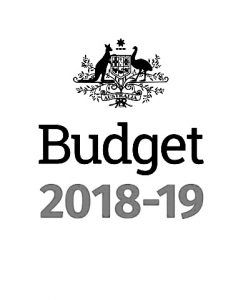
(Please note: Some of these proposals are still being debated within the government and some of the proposed changes have not yet been legislated)
- Proposed increase to the Medicare levy from 2% to 2.5% in 2018 will no longer push through. Medicare Levy rate will remain at 2%.
- From 1 July 2019, SMSFs with a history good record keeping and compliance will have an audit every three years.
- An increase on the number of SMSF members – from four to six.
- Individuals aged 65-74 with superannuation balances below $300,000 will be permitted to make voluntary superannuation contributions in the first year that they do not meet the work test requirements..
- A proposed amendment to introduce a low and middle income tax offset to trim down the tax payable for low and middle income Australian residents in the 2018-19, 2019-20, 2020-21 and 2021-22 financial years; In addition, this proposal aim to and ensure that Australians will pay lower tax rate by making the tax system simpler and protect middle income earners.
- While there are changes to the private health insurance rebate for 2018 (refer to the table below), there will not be any changes to the income threshold and surcharge rate for calculating the Medicare Levy Surcharge.
- There is a slight increase for HECS/HELP income threshold. For 2017-2018 income year, the minimum threshold will be $55,874 from $54,868 in 2016-2017 income year (refer to the table below for the updated HECS/HELP repayment threshold).
- From 1 July 2018, individual taxpayers can apply for withdrawal of voluntary contributions made to their super for their first home.
- To qualify for the reduced the corporate tax rate from 30% to 27.5 % for 2017- 2018 income year, companies must have an annual turnover of less than $25 million and must be carrying a business and to be eligible for other small business tax concessions you must remain as a small business entity.
- The $20,000 asset write off for small business will still apply until 30 June 2018 given the aggregated annual turnover of the entity is under $10 million.
Things to consider for the 2017 – 2018 income year
1) The marginal thresholds will remain the same.
| TAX RATES 2017 – 2018 | |||
| Taxable Income | Tax on this income | Rate | |
| 0 – $18,200 | Nil | 0% | |
| $18,201 – $37,000 | 19c for each $1 over $18,200 | 19.00% | |
| $37,001 – $87,000 | $3,572 plus 32.5c for each $1 over $37,000 | 32.50% | |
| $87,001 – $180,000 | $19,822 plus 37c for each $1 over $87,000 | 37.00% | |
| $180,001 and over | $54,232 plus 45c for each $1 over $180,000 | 45.00% | |
2) Medicare levy low income threshold will remain the same as well, for taxpayers whose income is below the low income thresholds below the Medicare levy does not apply:
| Medicare levy low income threshold 2017-2018 | ||
| Low-income Threshold 2017 | Low-income Threshold 2018 | |
| Single tax payer | $21,655 | $21,655 |
| Single taxpayer eligible for SAPTO (Pensioners) | $34,244 | $34,244 |
| Family combined income with dependent(s) | $36,541 plus $3,356 for each dependent | $36,541 plus $3,356 for each dependent |
| Family combined income with dependent(s) eligible for SAPTO (Pensioners) | $47,670 plus $3,356 for each dependent | $47,670 plus $3,356 for each dependent |
3) Medicare levy surcharge threshold and private health insurance rebate for 2017- 2018 are summarised below. Your eligibility for rebate depends on the income you earned for the entire financial year, which maybe reduced if you have a higher income. (Note: Your income for MLS purposes is based on your combined income from your taxable income, reportable fringe benefits , reportable super contribution, total net investment losses and exempt income)
| MEDICARE LEVY SURCHARGE THRESHOLD 2017 – 2018 | ||||
| Status | Income threshold | |||
| Single | $90,000 or less | $90,001 – $105,000 | $105,001 –$140,000 | $140,001 or more |
| Family* | $180,000 or less | $180,001 – $210,000 | $210,001 – $280,000 | $280,001 or more |
| Surcharge Rate | 0% | 1.00% | 1.25% | 1.50% |
| Age | Rebate for private health insurance premiums paid 1 July 2017 – 31 March 2018 | |||
| Under 65 yrs | 25.934% | 17.289% | 8.644% | 0.000% |
| 65 – 69 yrs | 30.256% | 21.612% | 12.966% | 0.000% |
| 70 yrs or over | 34.579% | 25.934% | 17.289% | 0.000% |
*Note: The family income threshold is increased by $1,500 for each Medicare levy surcharge dependent child after the first child.
5) Changes in HECS/HELP income thresholds 2017-20188 are summarised below: (Note: Your income for HECS/HELP purposes is based on your combined income from your taxable income, reportable fringe benefits , reportable super contribution, total net investment losses and exempt income)
| HECS/HELP REPAYMENT THRESHOLD 2017 – 2018 | |
| Repayment threshold | Rate |
| Below $55,874 | Nil |
| $55,874 – $62,238 | 4.00% |
| $62,239 – $68,602 | 4.50% |
| $68,603 – $72,207 | 5.00% |
| $72,208 – $77,618 | 5.50% |
| $77,619 – $84,062 | 6.00% |
| $84,063 – $88,486 | 6.50% |
| $88,487 – $97,377 | 7.00% |
| $97,378 – $103,765 | 7.50% |
| $103,766 and above | 8.00% |
6) Changes in superannuation from 1 July 2017 are summarised below and will still apply in the 2018-2019 financial year:
- You will be able to claim the maximum tax offset of $540 if you contribute to an eligible super fund of your spouse, whether married or de-facto, and your spouse’s income is $37,000 or less (the spouse’s income threshold in 2016 is $10,800)
- The government will introduce a low income superannuation tax offset (LISTO). From 1 July 2017, eligible individuals with an adjusted taxable income up to $37,000 will receive a LISTO contribution to their super fund. The LISTO contribution will be equal to 15% of their total concessional (pre-tax) super contributions for an income year, capped at $500.
- From 1 July 2017, most people under 75 years old (including those aged 65 to 74 who meet the work test) can claim a deduction for personal after-tax super contributions where they meet certain conditions.
- From 1 July 2017, the annual non-concessional contribution cap will be reduced from $180,000 to $100,000 per year.
7) Tax relief for first home buyers still applies in 2018-2019 financial year:
From 1 July 2017, first home buyers can save for their first home deposit by being able to salary sacrifice into their super fund. In specific, first home buyers can contribute up to $15,000 per year and $30,000 in total from pre-tax income, then they can start withdrawing those funds from 1 July 2018 onwards. These contributions will only be taxed at 15 per cent in the super fund and the withdrawals taxed at first home buyers’ marginal rate, less 30 percentage points.




